37 Texas Caterpillars (Including Hairy and Fuzzy) With Pictures – Identification Guide
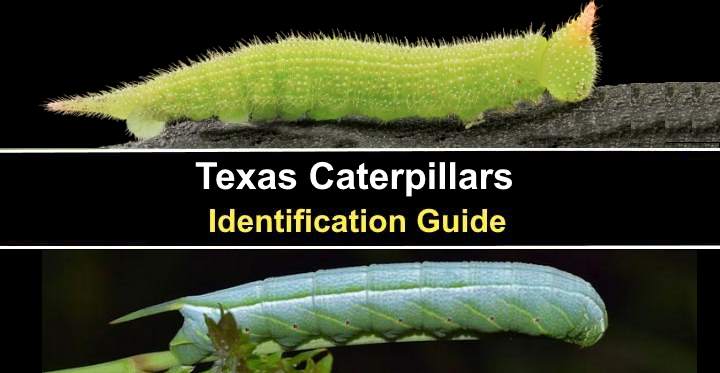
Texas is home to a variety of caterpillars in different shapes and sizes. These include stinging, horned, smooth-bodied, furry, and spiky types. The worm-like caterpillars often appear in green, black, or yellow hues. Additionally, specific markings on their body segments can aid in the identification of caterpillars in Texas.
Knowing how to identify caterpillars in Texas can help you tell the difference between stinging caterpillars and harmless ones. Additionally, it’s also good to know which furry caterpillars in the Lone Star State to avoid handling because they can cause skin irritation.
This article is an identification guide to the types of caterpillars you’ll find in Texas. Descriptions and pictures of slender, plump, and strange-looking caterpillars will help you identify the caterpillar species.
How to Identify Caterpillars in Texas
Caterpillars in Texas are identified by their cylindrical, worm-like bodies, six legs, and several stumpy prolegs. Identifying individual caterpillar species involves noting if they have hairy or smooth bodies, spikes, eye-like markings, or horns. In addition, many caterpillars have recognizable patterns to help distinguish them from other species.
Identifying species of caterpillars in Texas can be challenging. This is because the worm-like caterpillars go through several instars (growth stages). During these, they can change appearance, color, and shape. Also, some moth or butterfly larvae change color depending on their food source.
Caterpillars are the larvae of moths or butterflies and belong to the order Lepidoptera. They typically feed on plant foliage and can be found in groups or as solitary insects. Identifying the specific caterpillar species is essential, especially for managing pests that may impact ornamental shrubs, trees, or crops in Texas.
Stinging Caterpillars in Texas
Some of the common stinging caterpillars in Texas include the saddleback caterpillar, the Io moth caterpillar, the puss caterpillar, and the buck moth caterpillar. These caterpillars are usually found in gardens, parks, and forested areas. If you encounter a stinging caterpillar, it’s best to admire it from a distance and avoid touching it with bare skin. If stung, it is advisable to seek medical attention if the reaction is severe.
Stinging caterpillars have fine, sometimes barely visible, hollow spines that are connected to venom glands. When touched, these spines can cause mild to severe reactions, including pain, itching, rashes, and even more severe allergic reactions in some individuals.
Types of Caterpillars in Texas (With Pictures) – Identification Guide
Texas caterpillar species can be classified by color, the presence of setae (hairs), spikes, and if they sting or not. Of course, some caterpillars have several identifying features like being black and spiky or green and horned.
Green Caterpillars in Texas
Black Swallowtail Caterpillar (Papilio polyxenes)
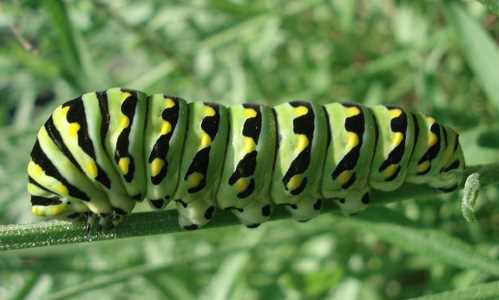
Black Swallowtail Caterpillar (Papilio polyxenes)
The black swallowtail caterpillar is a large green caterpillar with black and yellow-spotted stripes. An unusual feature of this larva is its forked gland that it shows to release a foul stink and ward off predators. Immature black swallowtail caterpillars are primarily black and white before turning green.
Green, black swallowtail caterpillars in Texas, grow up to 1.5” (40 mm) in their final instar when they are green with black bands. Black swallowtail caterpillars are poisonous and distasteful to bird predators.
After pupation, the green caterpillar turns into the stunning black swallowtail butterfly.
- Adult Stage: Black swallowtail butterfly
- Host Plants: Feeds on the leaves of various plants such as milkweed, including members of the carrot family (Apiaceae) such as parsley, dill, fennel, and Queen Anne’s lace
- Habitat and Distribution: Found in diverse habitats, including gardens, fields, meadows, and open areas, throughout North America
- Stinging: The black swallowtail caterpillar does not possess stinging capabilities or cause skin irritation
Cecropia Moth Caterpillar (Hyalophora cecropia)
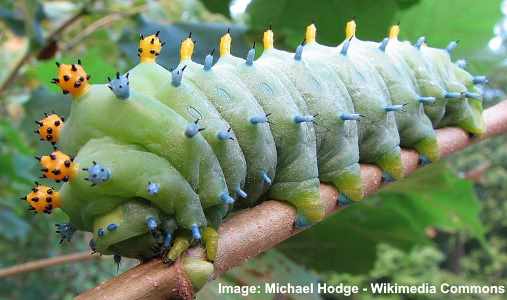
Cecropia Moth Caterpillar (Hyalophora cecropia)
The cecropia moth caterpillar is one of the unique looking caterpillars in Texas. The unusual lime-green caterpillar has large, ridged segments with longitudinal rows of colorful blue, yellow, and orange projections. Close-up pictures of this huge green caterpillar show tiny black spikes on the tubercles.
Cecropia moth caterpillars go through five instars where they gorge on maple, birch, and other trees and shrubs. Immature caterpillars turn from yellow-green to bluish-green. They eventually mature at 4” to 4.5” (100 to 110 mm) long, making them one of the largest caterpillars in Texas.
After emerging from the pupa, the cecropia moth caterpillar is the largest native moth in North America.
- Adult Stage: Transforms into the cecropia moth
- Caterpillar Feeds on: Various deciduous trees and shrubs, including maple, birch, and cherry
- Habitat: Found in woodlands and forested areas where host plants grow. Common in parts of North America
- Stinging: Does not sting
Polyphemus Caterpillar (Antheraea polyphemus)

Polyphemus Moth Caterpillar (Antheraea polyphemus)
The polyphemus moth caterpillar is a giant bright green silkworm characterized by rows of crimson red dots and wispy spines. The cylindrical-like green crawling insect is bright yellow when immature, gradually becoming bright green with red bumps before pupation. These fat caterpillars can grow 3” to 4” (75 – 100 mm) long.
The giant, plump silk moth caterpillar has a voracious appetite and can eat 86,000 times its own weight. After emerging from the cocoon, the green worm turns into a spectacular brown moth identified by conspicuous eyespots on its hind wings.
- Adult Stage: Transforms into the polyphemus moth
- Caterpillar Feeds on: Leaves of various deciduous trees, including oak and maple.
- Habitat: Found in woodlands and gardens where host trees grow. Commonly found in parts of North America
- Stinging: Does not sting
Eumorpha Sphinx Caterpillar (Eumorpha fasciatus)
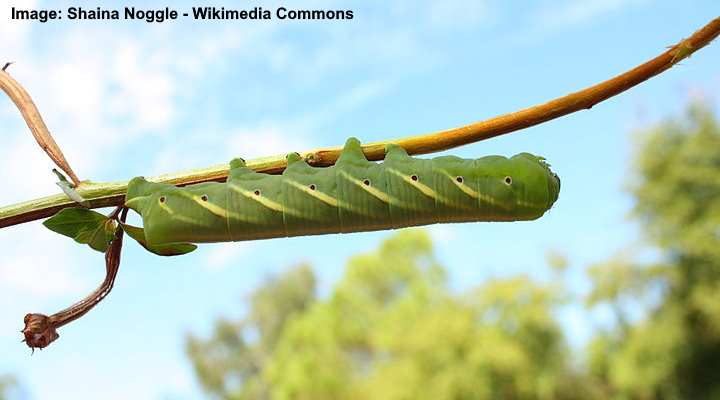
Eumorpha Sphinx Caterpillar (Eumorpha fasciatus)
Also called the banded sphinx caterpillar, this sizable green larva is identified by its diagonal yellow stripes, a row of black dots along its sides, and spiked tail. The enormous caterpillar is described as the most variable caterpillar in North America. Its colors can range from green to multicolored black, yellow, white, and orange.
The long protruding horn at its rear disappears in its green larval stage and becomes a pointed tail end. Before pupation, the engorged caterpillar turns pink or bright orange. The caterpillar is commonly found on plants in the evening primrose family.
- Adult Stage: Transforms into a sphinx moth within the Eumorpha genus
- Caterpillar Feeds on: Leaves of various plants, including grapevines
- Habitat: Found in gardens, woodlands, and vineyards. Common in parts of South America, Central America, and parts of USA
- Stinging: Does not sting
Carolina Sphinx Moth Caterpillar (Manduca sexta)

Carolina Sphinx Moth Caterpillar (Manduca sexta)
Also called the tobacco hornworm or goliath worm, the ginormous bright green caterpillar is recognized by its tube-shaped body with white diagonal stripes and black dots along its sides. The rear end of the large green larva also has a reddish or black horn. The Carolina sphinx moth caterpillar grows up to 2.7” (70 mm) long.
The large striped, green tobacco hornworm is easily confused with the related tomato hornworm. The difference between the two caterpillars is the abdominal markings. The tobacco hornworm has a single stripe, whereas the tomato hornworm has V-shaped markings.
- Adult Stage: Becomes the Carolina sphinx moth
- Caterpillar Feeds on: Tobacco, tomato, and other plants in the nightshade family (Solanaceae)
- Habitat: Found in gardens and agricultural fields. Common in North America
- Stinging: Does not sting
Honey Locust Moth Caterpillar (Syssphinx bicolor)
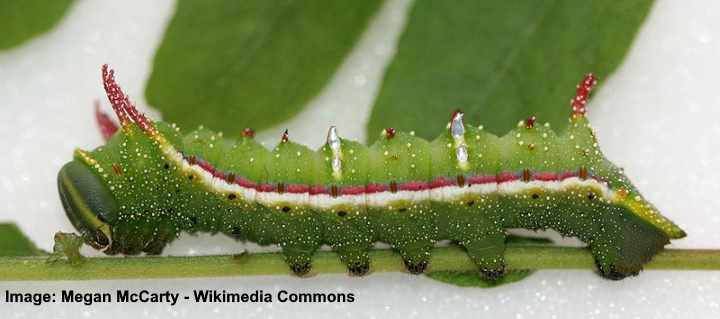
Honey Locust Moth Caterpillar (Syssphinx bicolor)
The honey locust moth caterpillar is an unusual green caterpillar with a white and red longitudinal stripe along each side. Other features of this bright green larva include red horns at either end and red or silvery protrusions on its body segments. Additionally, the green caterpillar is covered in yellowish-white spots.
The honey locust moth caterpillar is a type of green, horned caterpillar that grows up to 1.5” (38 mm). This spiky-looking caterpillar feeds exclusively on honey locust trees and Kentucky coffee trees.
- Adult Stage: Develops into the honey locust moth
- Caterpillar Feeds on: Leaves of honey locust trees
- Habitat: Found in woodlands and areas with honey locust trees. Not considered rare in regions in North America where honey locust trees grow
- Stinging: Does not sting
Cabbage White Caterpillar (Pieris rapae)
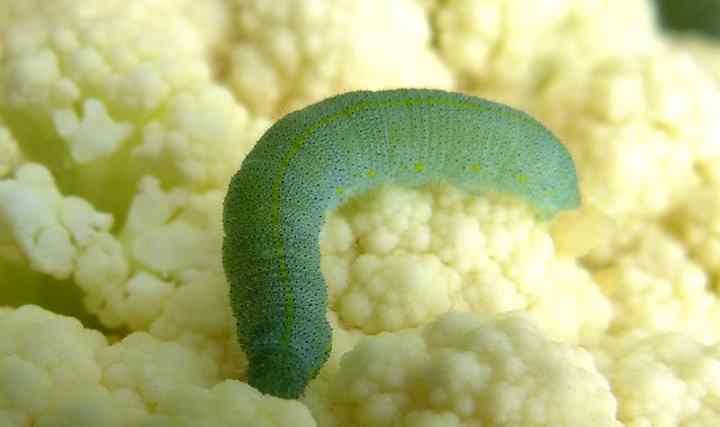
Cabbage White Caterpillar (Pieris rapae)
The cabbage white caterpillar is a long, slender green larva covered in tiny black pits. This green caterpillar also has bright yellow dots along its abdomen, a yellow stripe on its back, and is covered in fine setae. Changes in the caterpillar’s appearance are that its head changes from black in the first instar to pale green.
As a species of cabbage worm, this pest caterpillar is found destroying leaves on plants in the cabbage family. The slender worm-like creatures measure up to 1.1” (30 mm) and hide under cabbage, kale, mustard, and broccoli leaves. After pupation, the green caterpillar turns into a white butterfly.
- Adult Stage: Transforms into the cabbage white butterfly
- Caterpillar Feeds on: Various cruciferous plants, including cabbage, broccoli, and mustard
- Habitat: Found in gardens, agricultural areas, and open fields where host plants are cultivated. Common and widely distributed across North America and Europe
- Stinging: Does not sting
Long-Tailed Skipper Caterpillar (Urbanus proteus)
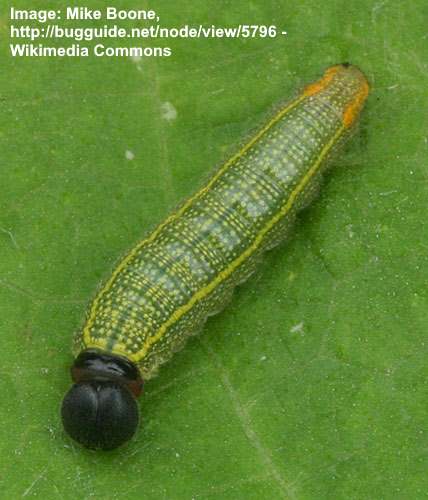
Long-Tailed Skipper Caterpillar (Urbanus proteus)
The long-tailed skipper caterpillar is a long cylinder-shaped green larva with a round black head, yellow stripes along its abdomen, spotted patterns, and orange patches on its tail. The most unusual feature of the yellow-spotted green caterpillar is its large head that looks like a swollen coffee bean.
Long-tailed skipper caterpillars grow up to 1.92” (49 mm). The destructive larvae munch on plant leaves in the pea family, wisteria, and other ornamental plants. Because it infests legumes, the green caterpillar is also called the bean leafroller.
- Adult Stage: Develops into the long-tailed skipper butterfly
- Caterpillar Feeds on: Leguminous plants, including beans and peas
- Habitat: Found in open areas, gardens, and fields. Common in parts of North and South America
- Stinging: Does not sting
Northern Pearly-Eye Caterpillar (Enodia anthedon)

Northern Pearly-Eye Caterpillar (Enodia anthedon)
The northern pearly-eye caterpillar is a pale green butterfly larva covered in short hairs and has rows of neon-like dots along its green body. In addition, this green caterpillar has two identifiable pale pink or orange-reddish horns on its head and a pointed tail. Northern pearly-eye caterpillars grow up to 1.77” (45 mm) before pupating.
You will often find these pale green, almost translucent caterpillars feeding on sedge plants and various types of grasses in Texas. The green caterpillar metamorphizes into an attractive grayish-brown butterfly native to North America.
- Adult Stage: Transforms into the northern pearly-eye butterfly
- Caterpillar Feeds on: Grasses, sedges, and other herbaceous plants
- Habitat: Found in grassy habitats, including woodlands and meadows. Commonly found in North America
- Stinging: Does not sting
White-Lined Sphinx Caterpillar (Hyles lineata)
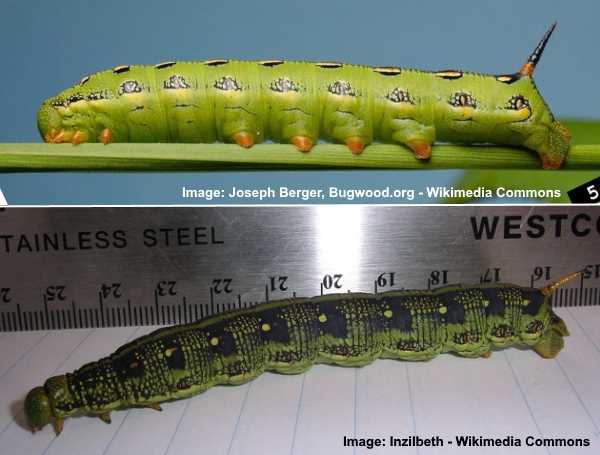
White-Lined Sphinx Caterpillar (Hyles lineata)
The white-lined sphinx caterpillar is a green, cylindrical caterpillar, identified by its abdominal black and yellow markings, black or orange horn, and orange legs. The lime green caterpillar has several variations. Some instars are dark green with black and yellow spots, whereas others are yellow caterpillars with black stripes.
The long, slender green spotted or striped caterpillar measures up to 2.7” (70 mm). Groups of these large green caterpillars can do tremendous damage to crops and ornamental plants.
- Adult Stage: Develops into the white-lined sphinx moth
- Caterpillar Feeds on: Various plants, including members of the nightshade family (Solanaceae)
- Habitat: Found in a variety of habitats, including deserts, gardens, and open fields. Commonly seen in North and South America
- Stinging: Does not sting
Genista Broom Moth Caterpillar (Uresiphita reversalis)

Genista Broom Moth Caterpillar (Uresiphita reversalis)
The genista broom caterpillar is an olive green caterpillar with black and white dots. It can be identified by its black oval head with white dots. Each segment of its body also has a number of white and black markings. Although not classified as a furry type of caterpillar, there are wispy white spines sticking out from its body.
The small genista broom caterpillar measures around 1 to 1.5 inches (2.5 to 3.8 cm) in length. You can often find this brownish-green caterpillar crawling on sweet peas, honeysuckles, and various deciduous plants.
- Adult Stage: Turns to genista broom moth
- Caterpillar Feeds on: Primarily feeds on broom plants, including genista species
- Habitat: Typically found in areas where broom plants grow, such as meadows and open woodlands. Found in various countries including the United States, Canada, and others in North America and Europe
- Stinging: Does not sting
Black Caterpillars in Texas
Pipevine Swallowtail Caterpillar (Battus philenor)
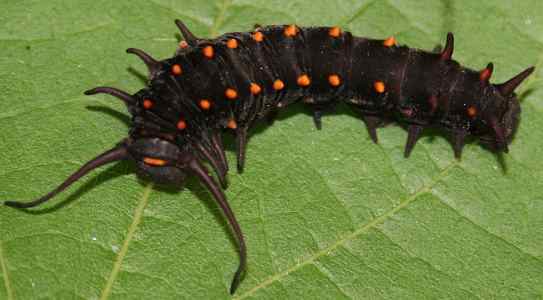
Pipevine Swallowtail Caterpillar (Battus philenor)
The pipevine swallowtail caterpillar is a black caterpillar with fleshy dark brown spines and two rows of bright orange dots. The dark brown or black caterpillars have a velvety appearance due to being covered in fine hairs. At the caterpillar’s head are two extended tubercles that look like horns.
Black pipevine swallowtail caterpillars measure up to 2” (50 mm) long. Although black is the dominant color, the caterpillar can also be bright red in warm climates like Texas, Florida, and Arizona.
- Adult Stage: Pipevine swallowtail butterfly
- Host Plants: Feeds on various species of pipevine plants, including the Dutchman’s pipe (Aristolochia species)
- Habitat and Distribution: Found in a variety of habitats such as forests, woodlands, and gardens, primarily in the southern and eastern regions of North America
- Stinging: Does not possess stinging capabilities or cause skin irritation
Stinging Caterpillars in Texas
Texas is home to several species of stinging caterpillars, with the furry southern flannel moth one of the most common.
Southern Flannel Moth (Puss) Caterpillar (Megalopyge opercularis)
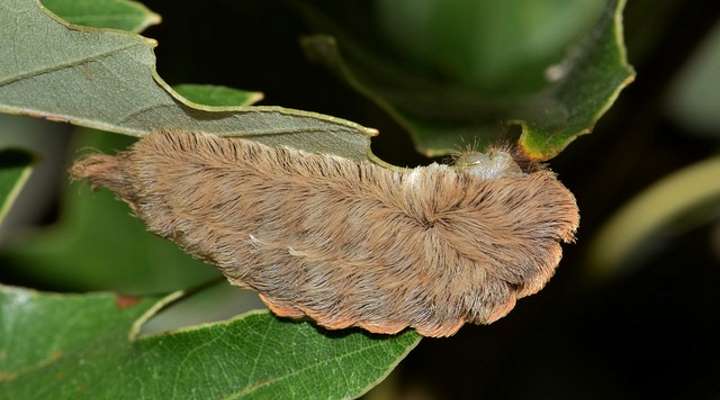
Southern Flannel Moth Caterpillar (Megalopyge opercularis)
The southern flannel moth (puss) caterpillar is a hairy stinging caterpillar found in Texas. It is teardrop-shaped and covered in dense, silky hairs that can range in color from light brown to gray or even reddish-brown. The furry caterpillar may appear soft and cute, but its fine golden-brown hairs conceal venomous spines. This common Texas stinging caterpillar measures between 1” and 1.5” (25 – 38 mm) in length.
Despite the southern flannel moth caterpillar’s soft, fur-like appearance, it can give a nasty sting. Even just brushing against this brown, hairy venomous caterpillar can cause severe throbbing pain, swelling, and redness on your skin. In some cases, an allergic reaction to the caterpillar’s sting requires medical attention.
- Adult Stage: Transforms into the southern flannel moth
- Host Plants: Puss caterpillars are commonly found on hackberry, elm, plum, sycamore, oak and rose
- Habitat and Distribution: The puss caterpillar is commonly found in Florida but is most abundant in Texas, particularly from Dallas southward in the western-central part of the state
- Stinging: The puss caterpillar is a toxic stinging caterpillar that gives a nasty sting. Symptoms from the sting of a puss caterpillar can vary in severity and may include headache, nausea, fever, and seizures. Medical attention is advised if symptoms continue to worsen
Saddleback Caterpillar (Acharia stimulea)

Saddleback Caterpillar (Acharia stimulea)
The saddleback caterpillar is one of the most unusual Texas stinging caterpillars. The spiky rectangular caterpillar has four protruding spine-covered fleshy structures at each corner and smaller stinging organs around its sides. In addition, the brown caterpillar has a green “saddle blanket” on its back with a brown patch in the center, making it easy to spot in a landscape.
The saddleback caterpillar grows 0.78” to 1” (20 – 25 mm) long. Getting stung by one of these stinging Texas caterpillars can cause intense burning and inflammation. The venom-filled spines easily break off and become embedded in the skin. The most common result is intensely itchy red welts.
- Adult Stage: Saddleback moth
- Host Plants: Feeds on a variety of plants including elm, sycamore, and maple, as well as other deciduous trees and shrubs
- Habitat and Distribution: Found in various habitats such as gardens, forests, and urban areas, primarily in North America
- Stinging: The saddleback caterpillar possesses spines that can cause skin irritation and stinging if touched
Peacock Moth Caterpillar (Automeris io)
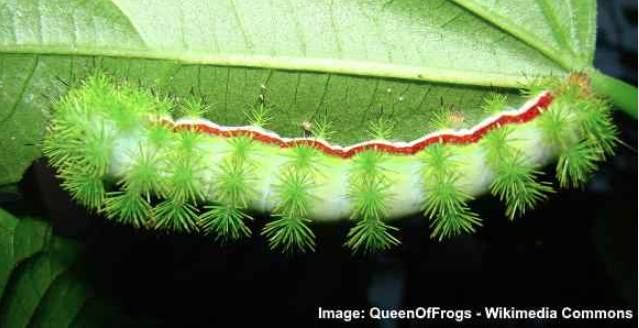
Peacock Moth Caterpillar (Automeris io)
Also called the Io moth caterpillar, this spiky green caterpillar is covered in urticating spines. The venomous caterpillar is bright green with a red and white stripe along its sides. Each segment features spiky clusters of bright green, venom-filled spines. The peacock moth caterpillar measures up to 2.3” (60 mm) long.
Close-up pictures of the stinging caterpillar show that the venomous spines are bright yellowish-green with black tips. The resulting sting from this native Texas caterpillar results in a burning sensation and skin swelling that lasts for up to eight hours.
- Adult Stage: Transforms into the io moth
- Host Plants: The caterpillar primarily feeds on a variety of broadleaf trees and shrubs, including corn, roses, willow, linden, elm, oak, locust, apple, beech, ash, currant, and clover
- Habitat and Distribution: Commonly found in gardens, forests, and meadows across North America, particularly in the eastern and central regions
- Stinging: May deliver a painful sting if handled
Hickory Tiger Moth Caterpillar (Lophocampa caryae)
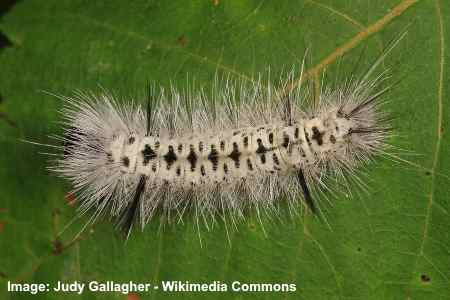
Hickory Tiger Moth Caterpillar (Lophocampa caryae)
The hickory tiger moth is a creamy white fuzzy caterpillar with black diamond markings on its back and is covered in tufts of white and black hairs. Identifiable features of this white stinging caterpillar are its tufts of black hair pencils and rounded black head. The furry white and black caterpillar measures around 1.77” (45 mm) long.
Although the white hickory tiger moth doesn’t have venom-filled spines, its urticating hairs can cause an itchy rash when handled. The barbed hairs lodge into the skin, resulting in mild to intense irritation and skin rashes.
- Adult Stage: Transforms into the hickory tussock moth
- Host Plants: The caterpillar primarily feeds on hickory and walnut trees
- Habitat and Distribution: Found in forests and woodlands across North America
- Stinging: Yes, the hairs of this caterpillar can cause skin irritation
Stinging Rose Caterpillar (Parasa indetermina)
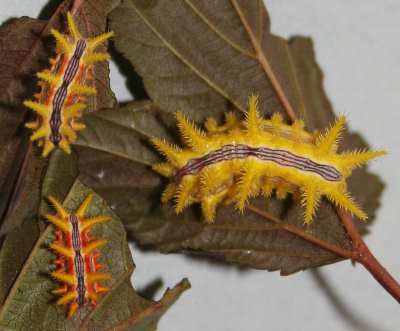
Stinging Rose Caterpillar (Parasa indetermina)
One of the most colorful stinging larvae is the stinging rose caterpillar. Brushing against this type of caterpillar can leave you with an itchy, irritating rash.
This caterpillar is identified by clusters of bright yellow spines sticking out from its body. There are prominent spiky horns along its side, front, and rear. Some types of these larvae have red-colored bodies with rows of purple or black stripes along their back. Others are a type of yellow caterpillar that have white and blue stripes.
Stinging Rose caterpillars are found in Florida, Texas, Oklahoma and other states on the Eastern coast of the US. They love to feed on apple, hickory, oaks, and maples. It is their preference of munching rose bushes that gives them their common name.
- Adult Stage: Stinging rose caterpillar moth
- Host Plants: Feeds on a variety of plants including rose bushes, hibiscus, and other ornamental plants
- Habitat and Distribution: Found in gardens, parks, and forested areas, primarily in North America
- Stinging: The stinging rose caterpillar possesses spines that can cause skin irritation and mild stinging if touched
Furry Caterpillars in Texas
Banded Woolly Bear (Pyrrharctia isabella)
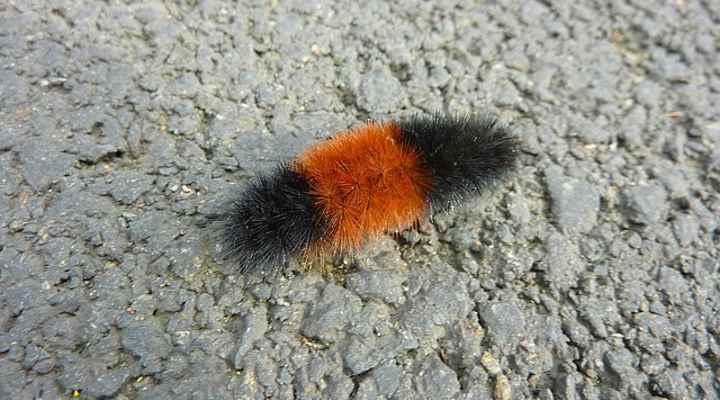
Banded Woolly Bear (Pyrrharctia isabella)
The banded woolly bear is a furry orange and black caterpillar commonly found in Texas. The black fuzzy caterpillar has a distinctive broad orange band on its middle section. As the hairy caterpillar matures, it becomes less black and more reddish-orange as it near pupation. The furry caterpillar measures 2” (50 mm) when mature.
Unlike other species of furry caterpillars, the black and orange woolly bear doesn’t sting. However, the black and orange spines are relatively sharp, despite the caterpillar’s soft, cuddly appearance, and may cause skin irritation in some people. A characteristic habit of the banded woolly caterpillar is rolling into a ball when under threat.
- Adult Stage: The adult form of this caterpillar is the Isabella tiger moth
- Host Plants: Woolly bear caterpillars are known to feed on a variety of plants such as aster, clover, birch, maple, elm, sunflower, and corn
- Habitat and Distribution: They can be found in open fields, gardens, and meadows across North America, particularly in the United States and southern Canada
- Stinging: Handling one of these fuzzy worm-like creatures with their spiky tufts of hair may cause skin irritation or contact dermatitis
Salt Marsh Caterpillar (Estigmene acrea)
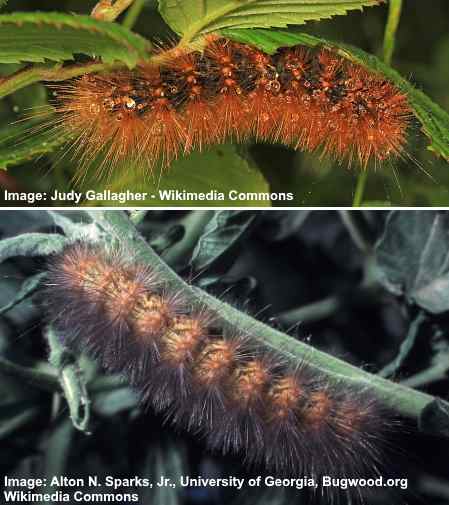
Salt Marsh Caterpillar (Estigmene acrea)
The salt marsh caterpillar is a slender black and brown larva covered in long orangey-red or black hairs. The fine wispy hairs on this Texas caterpillar grow in tufts, with several on each segment. Other characteristics of the salt marsh caterpillar are its rows of black or orange warts with white dots.
The brown hairy salt marsh caterpillar measures 2” (50 mm) long. The furry caterpillar also has variations in color, with some looking rusty brown and others dark brownish-black. The Texas hairy caterpillar feeds on cabbage, dandelion, pea, potato, and cotton plants.
- Adult Stage: Salt marsh moth
- Host Plants: Grasses, clover, dandelion, sunflower, and other herbaceous plants
- Habitat and Distribution: Salt marshes, meadows, and other open areas in North and South America
- Stinging: The caterpillar of Estigmene acrea is not known to possess stinging hairs or cause significant skin irritation in humans. However, direct contact with the caterpillar may cause mild skin irritation in some individuals
Great Leopard Moth Caterpillar (Hypercompe scribonia)
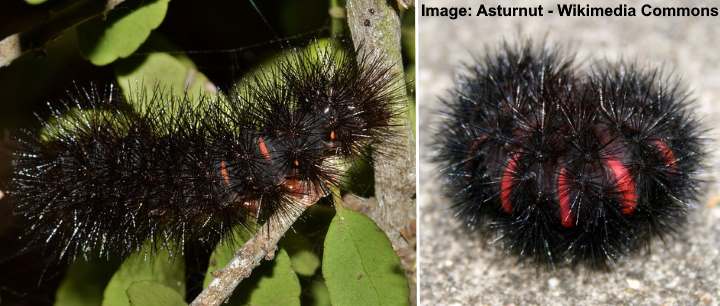
Great Leopard Moth Caterpillar (Hypercompe scribonia)
The great leopard moth caterpillar is a black furry caterpillar you’ll often find in Texas. A distinctive characteristic of this woolly larva is the bright red bands visible when the caterpillar rolls into a ball. The furry black larva grows up to 2” (50 mm) long.
The fuzzy black caterpillars often feed on weeds and are not considered pests. They are generally safe to pick up because their hairs are not venomous or cause irritation. The black Texas caterpillar changes into an attractive white moth with black ringed patterns on its wings.
- Adult Stage: Transforms into a beautiful moth known as the giant leopard moth. The adult moth is striking, with its black-and-white spotted pattern on its wings
- Host Plants: Feeds on a variety of plants, including dandelions, clover, violets, and other herbaceous vegetation
- Habitat and Distribution: These caterpillars are commonly found in gardens, fields, meadows, and woodlands throughout North America
- Stinging: Not known to sting or cause skin irritation
Striped Caterpillars in Texas
Monarch Caterpillar (Danaus plexippus)

Monarch Caterpillar (Danaus plexippus)
The monarch caterpillar is a tube-like insect with black, white, and yellow stripes. The striped Texas caterpillar also has a pair of fleshy horns at either end of its stripy abdomen. This southern caterpillar can grow into a harmless bug, with its length reaching up to 1.7” (45 mm) long and 0.3” (8 mm) in diameter.
The monarch caterpillar is a poisonous variety—a defense mechanism to protect it from predators. The giant, striped caterpillar feeds on milkweed, making it distasteful to birds and other predators.
However, the beautiful black, yellow, and white striped caterpillar is entirely harmless to humans, and you can safely handle it.
- Adult Stage: Monarch butterfly
- Host Plants: Mainly feeds on milkweed plants, including common milkweed, swamp milkweed, and others in the Asclepias genus
- Habitat and Distribution: Found in various habitats including fields, meadows, and gardens, primarily across North America, but also found in some parts of South America, Western Europe, and Australia
- Stinging: Monarch caterpillars do not sting or cause skin irritation
Passion Butterfly Caterpillar (Dione vanillae)
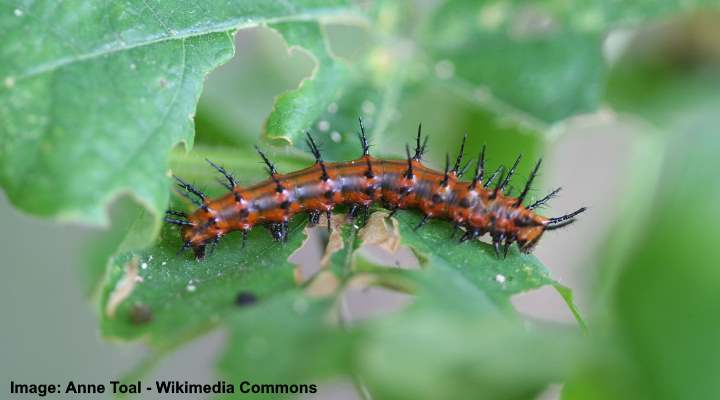
Passion Butterfly Caterpillar (Dione vanillae)
Also called the Gulf fritillary caterpillar, this spiky black and orange striped caterpillar is common in Florida and Texas. The small, slender worm-like larva has a spiked appearance due to the soft spiny black protrusions poking out from its orangey abdomen. The passion butterfly caterpillar measures 0.5” (12 mm) long.
After emerging from the pupation stage, the orange caterpillar becomes a stunning orange butterfly with attractive black and white markings on its wings.
- Adult Stage: Passion butterfly
- Host Plants: Passionflower vines (Passiflora species)
- Habitat and Distribution: Found in various habitats including gardens, open areas, and tropical forests across Central and South America, including countries such as Brazil, Mexico, and Costa Rica
- Stinging: This caterpillar is not known to sting or cause skin irritation
Unusual Caterpillars in Texas
Eastern Tiger Swallowtail Caterpillar (Papilio glaucus)
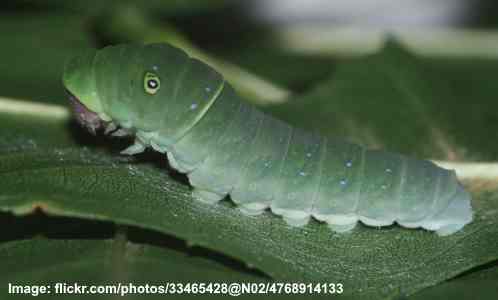
Eastern Tiger Swallowtail Caterpillar (Papilio glaucus)
The eastern tiger swallowtail caterpillar is classed as an unusual Texas caterpillar due to its large, realistic eye markings on its headin its final two instars. The short, stumpy dark green caterpillar starts off looking like bird droppings. It then becomes greener and develops eyespots on its thorax to deter birds. It becomes brown before pupating.
The eastern tiger swallowtail caterpillar grows up to 2.2” (55 mm) long.
- Adult Stage: Transforms into the tiger swallowtail butterfly
- Caterpillar Feeds on: Various deciduous trees, including black cherry, tulip poplar, and sweetbay magnolia
- Habitat: Found in woodlands, gardens, and open areas where host trees grow. Common and widely distributed across North America
- Stinging: Does not sting
Spicebush Swallowtail Caterpillar (Papilio troilus)
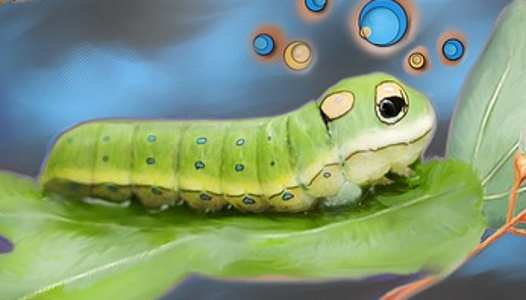
Spicebush Swallowtail Caterpillar (Papilio Troilus)
The spicebush swallowtail caterpillar is pale greenish-yellow with recognizable large yellow and black eyespots on its thorax. It’s one of the most unusual caterpillars in Texas. Other identifying features of this strange caterpillar are tiny blue and black markings and a longitudinal line along its abdomen.
Spicebush swallowtail caterpillars measure 2.1” (5.5 cm) long when mature.
- Adult Stage: Transforms into the spicebush swallowtail butterfly
- Caterpillar Feeds on: Spicebush and sassafras plants
- Habitat: Found in woodlands, gardens, and wetlands where host plants grow. Commonly found in parts of North America
- Stinging: Does not sting
Giant Swallowtail Caterpillar (Papilio cresphontes)
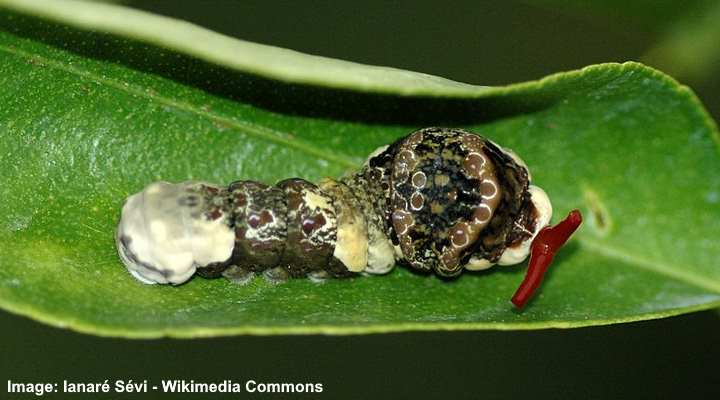
Giant Swallowtail Caterpillar (Papilio cresphontes)
The giant swallowtail caterpillar is a Texas caterpillar that looks like bird droppings. The nocturnal larvae have intricate camouflage patterns to protect them from predators. Sometimes the brown caterpillars have a saddle pattern; other times, it’s mottled shades of brown and white.
Before pupating, the unusual brown and white caterpillars measure 2” (50 mm). After emerging from the pupa, the distinctive caterpillars become one of the largest butterflies in North America—the giant swallowtail.
The giant swallowtail caterpillar also goes by the names orange dog, orange puppy, and bird poop caterpillar.
- Adult Stage: Giant swallowtail butterfly
- Host Plants: Citrus trees (Citrus species), including lemon, lime, and orange trees, as well as other plants from the Rutaceae family
- Habitat and Distribution: These caterpillars can be found in various habitats such as gardens, open areas, and forests, primarily in North America, including regions of the United States and southern Canada
- Stinging: The giant swallowtail caterpillar is not known to sting or cause skin irritation
Monkey Slug Caterpillar (Phobetron pithecium)
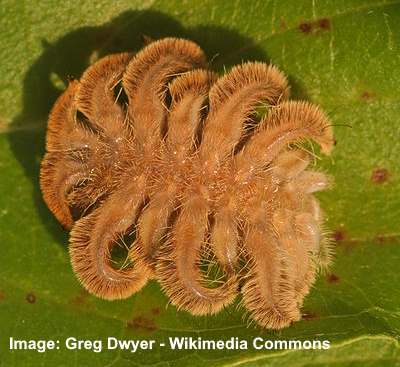
Monkey Slug Caterpillar (Phobetron pithecium)
The monkey slug caterpillar is unique because no other one looks like it. The hairy brown caterpillar has a flattened body with 18 hairy curled projections from its sides. This makes the weird caterpillar look like a squashed hairy spider or old leaf.
Monkey slug caterpillars have stinging hairs that can cause a painful sting if you handle it. The tiny brown hairy caterpillars grow up to 1” (2.5 cm).
- Adult Stage: Monkey slug moth
- Host Plants: Various trees and shrubs, including oak, cherry, and plum trees, among others
- Habitat and Distribution: Found in forests, woodlands, and gardens, primarily in the eastern regions of North America, including the United States and parts of Canada
- Stinging: The stinging hairs of this caterpillar can cause skin irritation. In some people, an allergic skin reaction may happen from handling a monkey slug caterpillar
Hickory Horned Devil Caterpillar (Citheronia regalis)
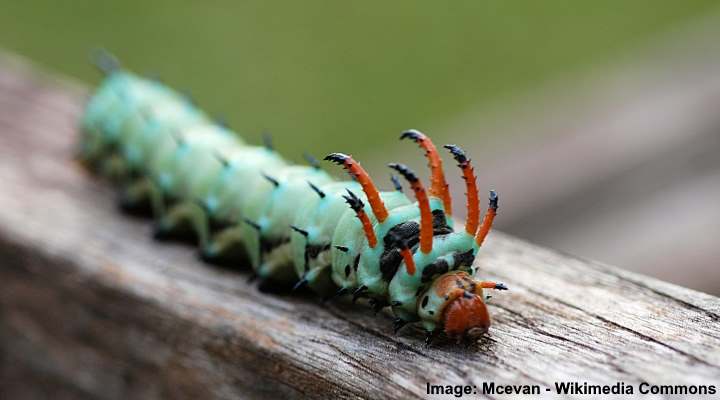
Hickory Horned Devil Caterpillar (Citheronia regalis)
The hickory horned devil caterpillar is one of the scariest caterpillars in Texas. However, the horned caterpillar is harmless and gentle despite its menacing appearance. The unusual Texas caterpillar has a bluish-green body, several curled black-tipped red horns, a small red head, and black spines along its abdomen.
The enormous turquoise caterpillar with its red head, red horns, and black spikes measures 5.5” (140 mm) long. The giant caterpillar is often found feeding on hickory trees in Texas.
- Adult Stage: Develops into the regal moth
- Caterpillar Feeds on: Various deciduous trees, including hickory, walnut, and ash
- Habitat: Found in woodlands and forested areas where host trees grow. Found in parts of North America
- Stinging: Does not sting
Red-Spotted Purple Caterpillar (Limenitis arthemis astyanax)
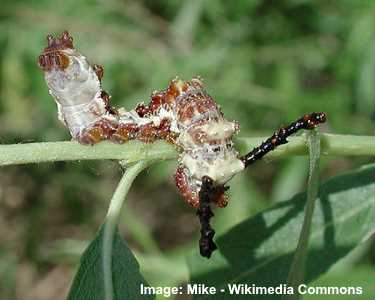
Red-Spotted Purple Caterpillar (Limenitis arthemis astyanax)
The red-spotted purple butterfly larva is a Texas caterpillar that looks like bird droppings. The weird brown caterpillar has a jagged appearance and white blotches. Apart from its irregular brown and white patterns, an identifying feature of the caterpillar is its thick black antennae-like horns.
The strange ugly caterpillar measures 1.6” (40 mm) long.
- Adult Stage: Red-spotted purple butterfly
- Host Plants: Various trees, including cherry, poplar, and willow, as well as other plants like apple, hawthorn, and aspen
- Habitat and Distribution: These caterpillars can be found in a variety of habitats, including deciduous forests, woodlands, gardens, and parks, primarily in North America, spanning from southern Canada to the eastern and central United States
- Stinging: The red-spotted purple caterpillar is not known to possess stinging capabilities or cause skin irritation
Orion Cecropian (Historis odius)
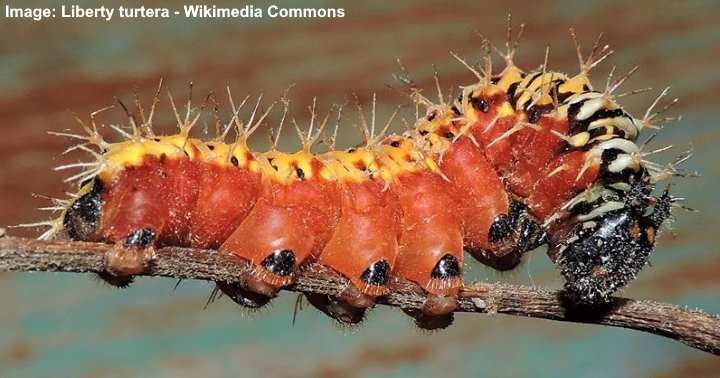
Orion Cecropian (Historis odius)
The Orion cecropian butterfly larva is a freakish-looking orange caterpillar with a distinctive spiky appearance. Characteristic features of the large, stumpy caterpillar are yellowish spines along its back, zebra-like marking on its thorax, and a shiny black head with dull orange dots. The large caterpillar measures 3” (75 mm) long.
The native North American orange and black caterpillar emits a repelling smell to ward off predators—a reason it’s also called the stinky leafwing caterpillar. As the sizable spiky caterpillar reaches its pupal stage, it becomes a spiky green caterpillar with yellowish spines.
- Adult Stage: Orion butterfly
- Host Plants: Caterpillars of the Orion cecropian feed on a variety of plants, including members of the Annonaceae family, such as the pawpaw tree (Asimina triloba), as well as plants from the Lauraceae family
- Habitat and Distribution: These caterpillars can be found in various habitats, including tropical and subtropical forests, as well as gardens and wooded areas, primarily in regions of Central and South America, including countries like Brazil and Mexico
- Stinging: The Orion cecropian caterpillar is not known to possess stinging capabilities or cause skin irritation
Spiky Caterpillars in Texas
Zebra Longwing Caterpillar (Heliconius charithonia)
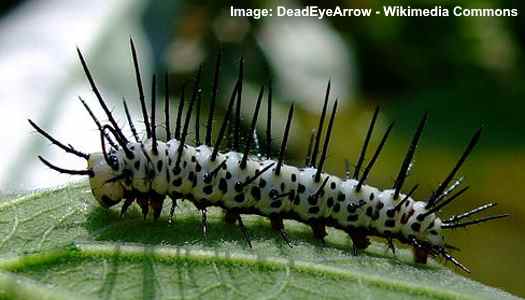
Zebra Longwing Caterpillar (Heliconius charithonia)
The zebra longwing caterpillar is a cream-white plump worm-like caterpillar with huge spiny spikes covering its body. The distinctive features of the white caterpillar are its black spots that turn deep red as the caterpillar matures. The white or grayish-white and black tube-like insect measures 0.5” (12 mm) long.
The spiky Texas caterpillar feeds on plants in the Passiflora genus. Compounds in the plant’s foliage create toxins in the larva, making the zebra longwing caterpillar poisonous to birds.
- Adult Stage: Zebra longwing butterfly
- Host Plants: Feeds on various passionflower vine species, including Passiflora suberosa and Passiflora incarnata
- Habitat and Distribution: Found in a variety of habitats such as tropical forests, gardens, and coastal areas, primarily in the southern United States, Mexico, Central America, and South America
- Stinging: The zebra longwing butterfly caterpillar does not possess stinging capabilities or cause skin irritation
Crimson Patch Caterpillar (Chlosyne janais)
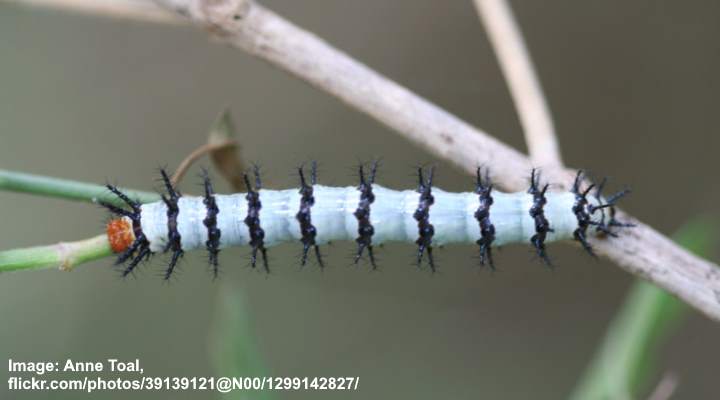
Crimson Patch Caterpillar (Chlosyne janais)
The crimson patch butterfly larva is a pale blue caterpillar with bands of black spikes around its abdomen. The slender, cylindrical crawling insect has an orange head, contrasting with its light blue and black colors. The native Texas caterpillar feeds primarily on scrubby plants in the Acanthaceae family.
Crimson patch caterpillars are found throughout Texas. However, the grayish-white tube-like larvae are most prolific in the Rio Grande Valley.
- Adult Stage: Crimson patch butterfly
- Host Plants: The caterpillars feed on plants from the Asteraceae family, including species such as sunflowers (Helianthus), asters, and coneflowers (Echinacea)
- Habitat and Distribution: These caterpillars can be found in various open habitats, including meadows, fields, and gardens, mainly in regions of North and Central America, including parts of the United States, Mexico, and Costa Rica
- Stinging: The crimson patch caterpillar is not known to possess stinging capabilities or cause skin irritation
Mourning Cloak Caterpillar (Nymphalis antiopa)
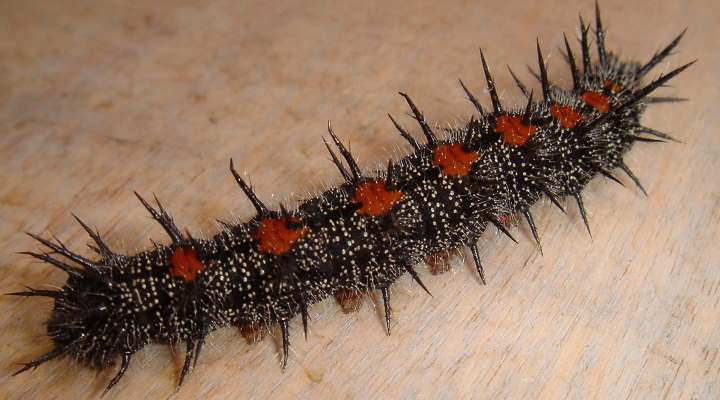
Mourning Cloak Caterpillar (Nymphalis antiopa)
The mourning cloak caterpillar is a spiky black caterpillar covered in tiny white dots and deep reddish-orange patches along its back. The slender cylindrical caterpillar also has tufts of small white setae on its black body. This jet-black caterpillar grows up to 2” (50 mm) long.
The long, black spiky caterpillar is common throughout Texas and the southern United States. The plant-destroying black “worms” feed on willow, elm, hawthorn, and birch tree leaves. You will often see the black caterpillars living in silken nests on the host trees.
- Adult Stage: The caterpillar transforms into the mourning cloak butterfly, known for its dark wings with bright yellow margins
- Host Plants: These caterpillars feed on various deciduous trees, such as willow, poplar, and elm
- Habitat and Distribution: Mourning cloak caterpillars can be found in woodlands, forests, and gardens across North America, Europe, and Asia
- Stinging: The caterpillars are covered with urticating hairs that can cause skin irritation. While the caterpillar appears spiky and intimidating, its spines are not venomous and are primarily a defense mechanism against predators
Red Postman Caterpillar (Heliconius erato)
Red Postman Caterpillar (Heliconius erato)
The red postman butterfly larva is a white caterpillar with black dots and branched black spines on its sides and back. The colorful caterpillar also has a yellow head, amber-colored legs, and yellowish spots at the base of the black spiny spikes. A unique identifying mark of the white caterpillar is its black stripe along its side.
The black-spotted white caterpillars are common in south Texas, Mexico, and Central America. These leaf-devouring caterpillars mainly feed on passiflora plants. After pupation, the white spiky caterpillar turns into a stunning black, red, and white butterfly.
- Adult Stage: Red postman butterfly
- Host Plants: The red postman caterpillar feeds on passionflower vines (Passiflora species) as its primary host plants
- Habitat and Distribution: These caterpillars are typically found in tropical and subtropical regions, including forests, gardens, and open areas, primarily in Central and South America, spanning countries such as Brazil, Mexico, and Colombia
- Stinging: Not known to possess stinging capabilities or cause skin irritation
Bordered Patch Caterpillar (Chlosyne lacinia)
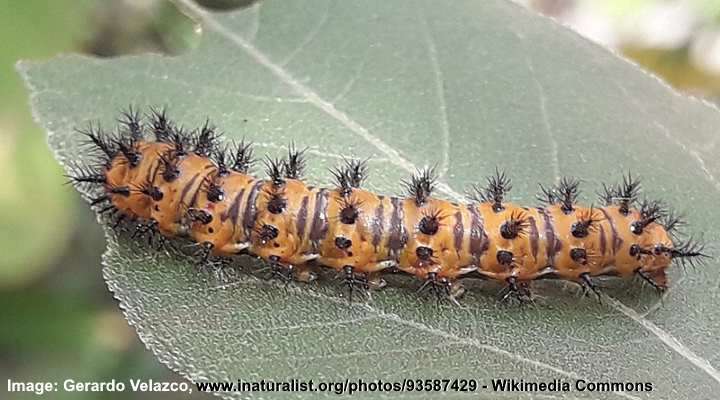
Bordered Patch Caterpillar (Chlosyne lacinia)
The bordered patch butterfly larva is an eye-catching orange caterpillar with several tufts of short black spikes traversing each segment. Other identifying features of the orange larva are dark, chocolatey-brown patches and a row of short, branched spines along its side.
The Texas orange bordered patch caterpillar feeds on various plants like Texas blueweed, ragweed, sunflowers, and Jerusalem artichoke. Another name for this spiky orange caterpillar is the sunflower patch caterpillar.
- Adult Stage: Bordered patch butterfly
- Host Plants: The bordered patch caterpillar feeds on various plants from the Asteraceae family, including species such as sunflowers (Helianthus) and asters
- Habitat and Distribution: These caterpillars can be found in a variety of open habitats, including meadows, fields, and gardens, primarily in regions of North and Central America, including parts of the United States, Mexico, and Costa Rica
- Stinging: The bordered patch caterpillar is not known to possess stinging capabilities or cause skin irritation
Other Common Caterpillars in Texas
Cloudless Sulphur Caterpillar (Phoebis sennae)
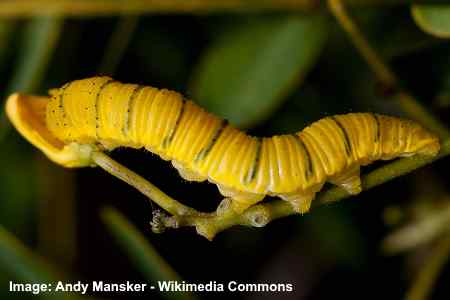
Cloudless Sulphur Caterpillar (Phoebis sennae)
The cloudless sulphur butterfly larva is a spectacular yellow caterpillar with black stripes across its back. Close-up pictures of the yellow-colored caterpillar show it’s got tiny spines on its black patches, and there are several black dots around its head area. The yellow caterpillars measure between 1.6” and 1.8” (41 – 45 mm) long.
Yellow cloudless sulphur caterpillars are usually found in Texas, feeding on plants in the legume family.
- Adult Stage: Transforms into the cloudless sulphur butterfly
- Caterpillar Feeds on: Various plants, primarily members of the legume family (Fabaceae)
- Habitat: Found in open areas, gardens, and fields. Common and widely distributed in the Americas
- Stinging: Does not sting
Orange-Barred Sulphur (Phoebis philea)

Orange-Barred Sulphur (Phoebis philea)
The orange-barred sulphur butterfly larva is a pale-yellow greenish caterpillar with two thick black stripes running from head to tail. The caterpillar’s abdomen and the head base are a leafy-green color. The striped Texas caterpillar also has several short, stumpy spines covering its yellowish-green body.
The color of orange-barred sulphur caterpillars depends on what they eat. Caterpillars that eat flowers are a yellower color, and caterpillars that eat leaves are a greener color. After pupation, the striped caterpillar turns into an eye-catching yellow butterfly.
- Adult Stage: Develops into the orange-barred sulphur butterfly
- Caterpillar Feeds on: Leaves of plants in the legume family (Fabaceae)
- Habitat: Found in various open habitats, including gardens and fields. Commonly seen in parts of the Americas
- Stinging: Does not sting
Silver-Spotted Skipper Caterpillar (Epargyreus clarus)
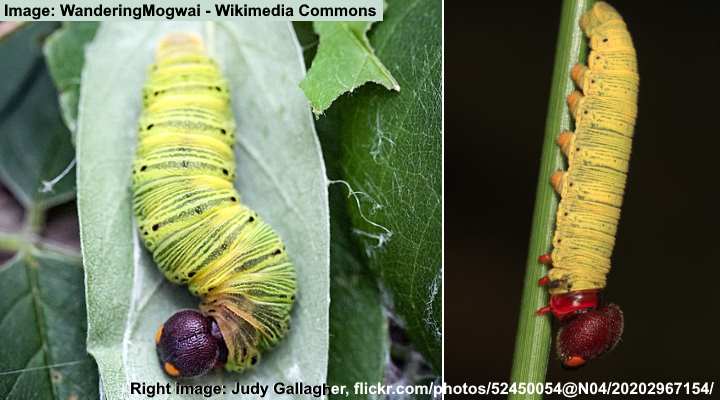
Silver-Spotted Skipper Caterpillar (Epargyreus clarus)
The silver-spotted skipper caterpillar is a plump, yellowish-green caterpillar with dark thin green stripes around its tube-like abdomen. This green caterpillar’s identifying feature is its round reddish-brown head with conspicuous orange eye-like spots. This crawling yellowish-green insect grows up to 2” (50 mm) long.
Silver-spotted skipper caterpillars are found throughout North America and feed on wisteria plants, legumes, locust tree foliage, and deciduous plants. After pupation, the yellow-green striped caterpillar turns into a brown butterfly that feeds on the nectar from red, pink, blue, and white flowers—but never yellow flowers.
- Adult Stage: Transforms into the silver-spotted skipper butterfly
- Caterpillar Feeds on: Leaves of leguminous plants, including beans and peas
- Habitat: Found in open areas, gardens, and fields. Common and widely distributed in North America
- Stinging: Does not sting
Texas Caterpillars – FAQ
What are the little fuzzy caterpillars in Texas?
In Texas, there are various types of fuzzy caterpillars, some of which include the puss caterpillar, the woolly bear caterpillar, and the salt marsh caterpillar. These caterpillars are known for their fuzzy or hairy appearance, which serves as a form of protection or camouflage. They can often be found in gardens, parks, forests, and other natural environments throughout Texas.
Are there poisonous caterpillars in Texas?
Yes, there are several species of poisonous or venomous caterpillars in Texas. Some of the well-known poisonous or stinging caterpillars in Texas include the puss caterpillar, the io moth caterpillar, the saddleback caterpillar, and the buck moth caterpillar. These caterpillars possess defensive mechanisms such as venomous spines, hairs, or bristles that can cause mild to severe reactions in humans if touched.
What do Texas caterpillars eat?
Caterpillars in Texas have diverse diets, depending on their specific species. Common food sources for Texas caterpillars include grasses, shrubs, herbs, and trees found in different ecosystems such as forests, meadows, gardens, and urban landscapes. Some caterpillars may be specialists, feeding exclusively on particular plant species, while others are generalists, consuming various plants within their habitat.
Related articles:
